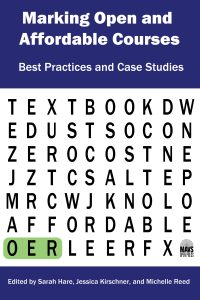Increasingly, colleges are choosing — or being required by state law — to inform students which courses on campus use open educational resources or other low cost materials. A new book shows higher education officials how to set up a workable system that makes it easy for students to find classes with free materials.
 Marking Open and Affordable Courses: Best Practices and Case Studies was released in May on a free, online platform. Edited by Michelle Reed, Jessica Kirschner, and Sara Hare, the book offers an analysis of the technology, legislation, and cultural change needed—and case studies to illustrate the process. It is designed for administrators, librarians, campus store managers, instructors, registrars, and others interested in affordable resource markings.
Marking Open and Affordable Courses: Best Practices and Case Studies was released in May on a free, online platform. Edited by Michelle Reed, Jessica Kirschner, and Sara Hare, the book offers an analysis of the technology, legislation, and cultural change needed—and case studies to illustrate the process. It is designed for administrators, librarians, campus store managers, instructors, registrars, and others interested in affordable resource markings.
Reed, the book’s project manager and Director of Open Educational Resources at the University of Texas at Arlington Libraries, started the path to the book’s publication in 2017 as a fellow in SPARC’s Open Education Leadership Program. The Texas legislature had just passed a law requiring institutions to start marking courses that assign OER, and institutions had to act quickly to comply with the requirements.
“We were very much on our own,” says Reed. Recognizing that institutions across the state were facing many of the same challenges as her home institution, Reed decided to tackle the problem through her fellowship capstone project, developing the Texas Toolkit for OER Course Markings as a guide for campuses to implement the new requirement.
Following the tookit’s release, it became clear there was more valuable material to convey and demand was growing as other states passed similar laws. So, Reed decided to team up with two colleagues and expand the project into a book.
“This project is emblematic of what open education leadership is: identifying a challenge, taking action to address that challenge, then engaging collaborators and the community to broaden the impact—leveraging effective open educational practices in the process,” said Nicole Allen, Director of Open Education for SPARC.
Since the book would be about the use of open educational resources, Reed decided it was important to be a model for open, transparent publishing. Her team connected with the Rebus Community, and signed on to use its web-based software for managing open textbook projects.

Michelle Reed, Director of Open Educational Resources at the University of Texas at Arlington Libraries
“It was important for me, as an OER librarian, to understand and experience the open work flow I was recommending for UTA faculty,” Reed says. “We can be more effective advocates of open practices and better support the labor of this work when we’ve experienced it firsthand.”
In July 2018, Reed and her co-editors issued an open call for contributors to the book. Contributor proposals were posted on a public discussion board and reviewed, resulting in 30 authors contributing to the collaboratively authored text. Throughout the editing process, all contributors were given access to the full manuscript and were encouraged to read the other sections and make suggestions.
Last fall, 29 reviewers read and provided feedback on the manuscript using Hypothesis, an open source web annotation tool. All feedback was identifiable by reviewer and shared with the book’s 30 authors. Though efforts were made to involve participants from various stakeholder groups, most volunteers were librarians.
Nine case studies in the book are examples from various types of institutions, including community colleges, liberal arts colleges, and research institutions. The initial challenge is often just getting started so the examples are intended to help readers see what OER tagging looks like on campus.
“We are not prescribing one approach to course marking,” Reed says. “This is going to vary by the institutional context of your campus. We hope readers will pull out what works for them. It is meant to be practical.”
Pushing back on traditional notions of authorship, Reed says everyone who contributed to the book is listed alphabetically. Authors on the project included: Breeman Ainsworth, Nicole Allen, Jessica Dai, Abbey Elder, Nicole Finkbeiner, Amie Freeman, Sarah Hare, Kris Helge, Nicole Helregel, Jeanne Hoover, Jessica Kirschner, Joy Perrin, Jacquelyn Ray, Jennifer Raye, Michelle Reed, John Schoppert, and Liz Thompson. The second half of the text features case studies by Alexis Clifton, Rebel Cummings-Sauls, Michael Daly, Juville Dario-Becker, Tony DeFranco, Cindy Domaika, Ann Fiddler, Andrea Gillaspy Steinhilper, Rajiv Jhangiani, Brian Lindshield, Andrew McKinney, Nathan Smith, and Heather White.